order
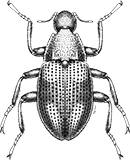
Coleoptera
“Adult Beetles”

Coleoptera
“Larval Beetles”

Diptera
“True Flies”

Ephemeroptera
“Mayflies”
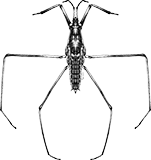
Hemiptera
“True Bugs”

Lepidoptera
“Aquatic Caterpillars, Snout Moths”

Megaloptera
“Alderflies, Dobsonflies, and Fishflies”
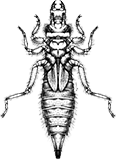
Odonata
“Dragonflies and Damselflies”
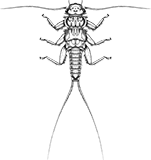
Plecoptera
“Stoneflies”
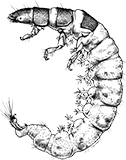
Trichoptera
“Caddisflies”
family
Rhyacophilidae
genus
Rhyacophila
“Free-living, Green Caddisflies”
Genus Overview
Rhyacophila is the only genus from the family Rhyacophilidae in the United States east of the Rocky Mountains; it is widespread except less common in the Great Plains (absent from southern Great Plains). The larvae exhibit a variety of feeding strategies, they may be engulfing predators, especially as mature larvae, but also collector-gatherers, scraper-grazers, or shredder-herbivores. Larvae are free-living, meaning that they do not live in a case or retreat, but simply move throughout the environment, clinging to the substrate and pursuing prey. Before pupation, they build a rock shelter and spin a semipermeable cocoon inside it. Larvae are often, but not always, green in color, and often have well-defined segments, giving the body a beaded appearance. They can be readily identified using the following characters: sclerotized pronotum, membranous meso- and metanota, abdominal tergum IX with a sclerite, and anal prolegs free, not closely fused to segment IX.
Characteristics
POLLUTION TOLERANCE
Southeast: 0
Upper Midwest: 0
0 = least tolerant, 10 = most tolerant
FEEDING HABITS
Collector / Gatherer
Engulfer / Predator
Scraper / Grazer
Shredder / Herbivore
Engulfer / Predator
Scraper / Grazer
Shredder / Herbivore
MOVEMENT
Clinger
DISTRIBUTION
Widespread (east of the Rocky Mtns.)
HABITAT
Lotic-erosional
Diagnostic Characters
order
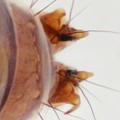
Prolegs With Single Hook
family
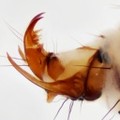
Anal Prolegs Free

Free-living
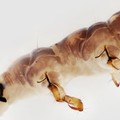
Meso- And Metanota Membranous.
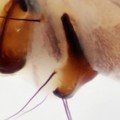
Sclerite On Segment IX
genus
NO IP
Only 1 Genus
+ Expanded Character List
Order:
Larvae: Wings/wing pads absent. Eye spots present, but compound eyes absent. Antennae usually small, inconspicuous. Three pairs of segmented legs present on thorax. Pair of anal prolegs, each with single hook, located on last abdominal segment. Larvae can be free-living, in silken retreats attached to substrate, or in usually-portable tubes or cases made of sand, rocks, or plant material.
Family:
Antenna small and inconspicuous. Pronotum without lobes in anterior corners. Meso- and metanota membranous. Metanotum with lateral setal areas (sa3) each with only a single seta, with or without a sclerite. Abdominal tergum IX with a sclerite, sometimes inconspicuous or retracted under intersegmental fold of abdominal tergum VIII. Anal prolegs free, not closely fused to segment IX. Anal claw without dorsal accessory hook; however, sometimes with a secondary lateral claw and sometimes with ventral teeth. Larvae are free-living until pupation.
Genus:
Rhyacophila is the only genus from the family Rhyacophilidae in the United States east of the Rocky Mountains, so family-level and genus-level diagnostic characters are the same except eastern species lack filamentous gills. Mature Rhyacophila larvae are less than 25 mm (1 inch) long. Widespread.

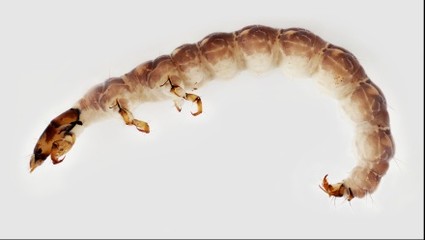
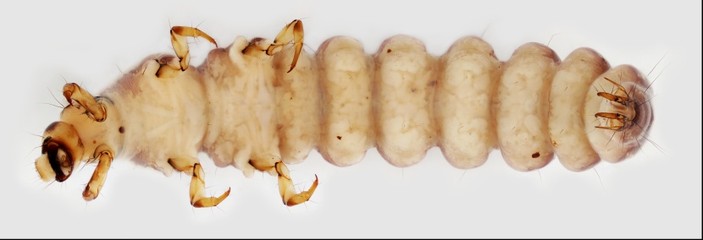
Dorsal
Lateral
Ventral




